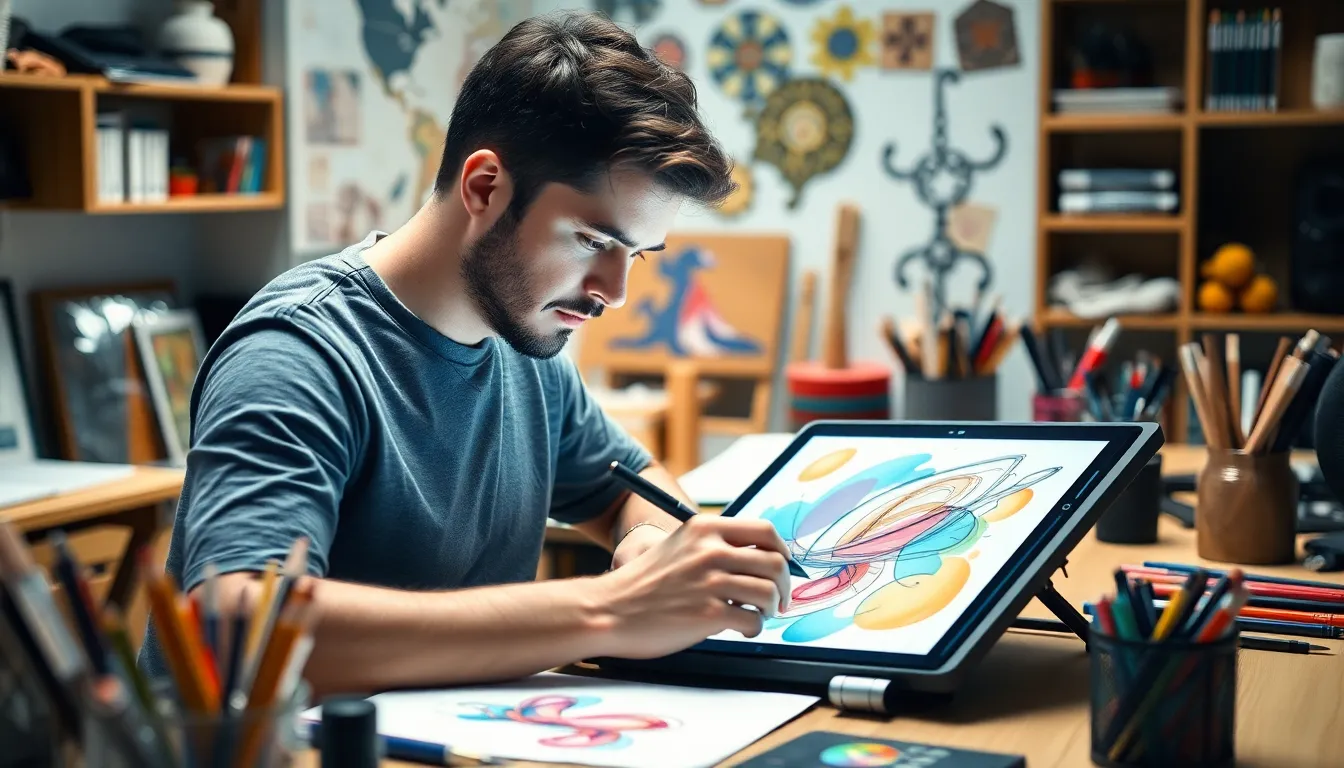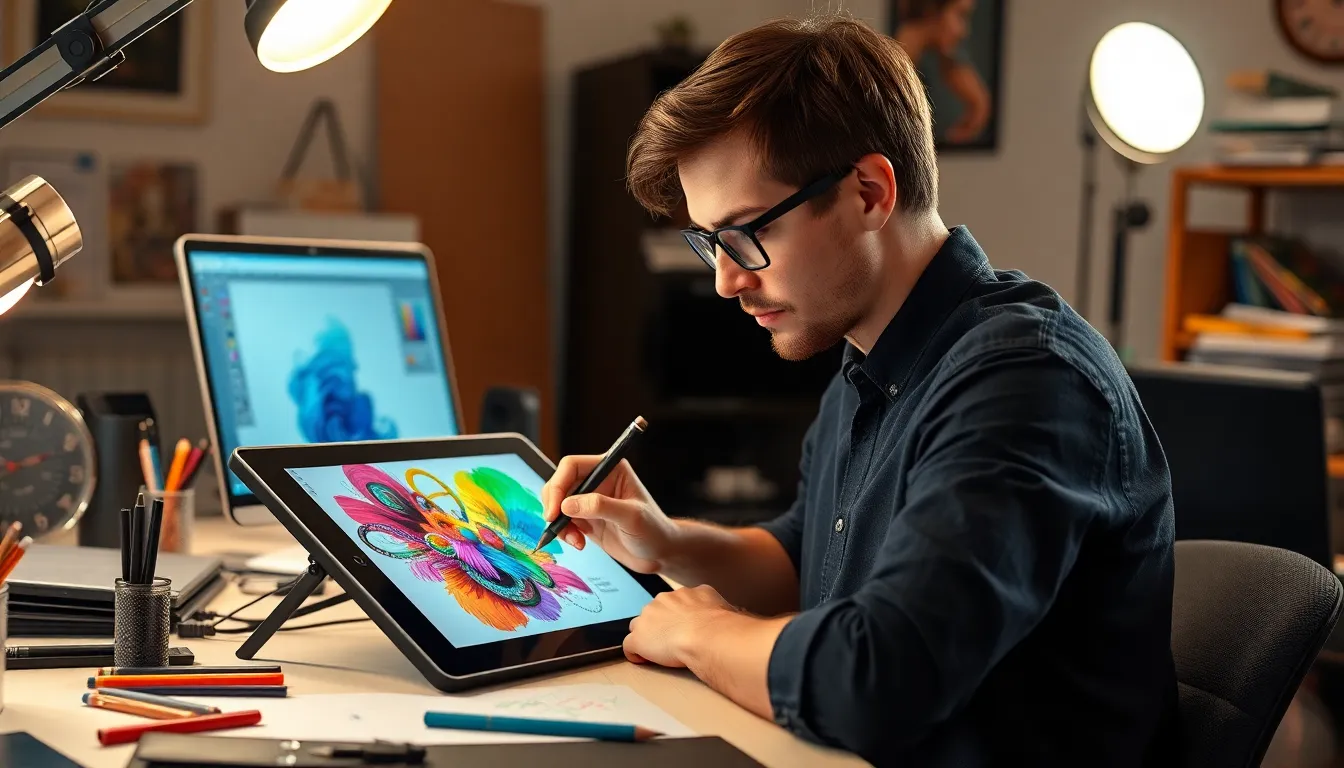In a world where creativity meets technology, drawing tablets have emerged as the superhero sidekick for artists everywhere. They’re not just fancy screens; they’re magical portals that transform doodles into digital masterpieces. Ever wondered how these sleek gadgets translate a simple pen stroke into a vibrant image? Spoiler alert: it’s more than just witchcraft!
Table of Contents
ToggleUnderstanding Drawing Tablets
Drawing tablets function as digital canvases that enable artists to create artwork using a stylus. These innovative devices translate physical movements into digital commands, allowing for precise and detailed creations.
What Are Drawing Tablets?
Drawing tablets are specialized input devices designed for digital illustration, graphic design, and photo editing. They consist of a flat surface that tracks stylus movement. This interaction creates seamless transitions between traditional drawing techniques and digital art. Users can draw, sketch, and paint directly onto the tablet, which captures every stroke. As a result, artists can enjoy a more intuitive experience than using a mouse or trackpad.
Types of Drawing Tablets
Different drawing tablets cater to various needs and skill levels. Graphics tablets connect to a computer and rely on screen display, while pen display tablets showcase images directly on their surface. Standalone tablets function independently, allowing users to create art without a computer. Each type offers unique advantages, from portability to enhanced functionality. Artists can choose based on their preferences, workflow needs, or budget constraints.
The Technology Behind Drawing Tablets

Drawing tablets leverage advanced technology to replicate traditional art techniques digitally. Understanding this technology offers insight into their functionality and versatility.
Pressure Sensitivity
Pressure sensitivity defines how well a drawing tablet detects and responds to different levels of pressure applied with a stylus. This feature enables artists to create varied line thickness and opacity by simply adjusting their grip on the stylus. Most professional-grade tablets provide levels of pressure sensitivity ranging from 256 to 8192. Such precision allows for intricate detailing in artwork, resulting in more dynamic and expressive designs. Artists appeal to this functionality for its ability to mimic the subtleties of traditional media, which enhances their illustration experience.
Screen Technology
Screen technology plays a crucial role in the performance of drawing tablets. Two primary types dominate the market: LCD and OLED screens. LCD screens offer clarity and brightness, making them suitable for most tasks. In contrast, OLED screens provide deeper blacks and more vibrant colors, which can enhance visual performance for digital artists. Additionally, certain tablets feature touch-sensitive screens that allow for gestures, streamlining the creative process. Artists appreciate high resolution and color accuracy, helping them achieve results that closely reflect their creative vision.
The Connection Process
Connecting a drawing tablet to a computer or device involves several methods, each with its own advantages. Both USB and wireless options offer flexibility.
USB vs. Wireless
USB provides a direct connection between the tablet and computer, ensuring a stable data transfer. This option minimizes latency, which is crucial for real-time drawing. Most drawing tablets come with a USB cable, making setup straightforward. Wireless connections, on the other hand, offer mobility. Users can draw freely without being tethered to a device. Bluetooth is commonly used for this purpose, though it may introduce some lag depending on the model and environment. Each method has its fans, and preference often depends on the artist’s unique workflow.
Compatibility with Software
Compatibility plays a vital role in maximizing a drawing tablet’s potential. Most tablets work seamlessly with popular design software like Adobe Photoshop, Illustrator, and Corel Painter. Artists should ensure their tablets support the required software to avoid functionality issues. Software developers frequently release drivers and updates, enhancing performance and adding features. Regular updates to both tablet firmware and software keep the user’s experience optimized. Exploring compatibility ensures artists can tap into every creative opportunity available.
Features of Drawing Tablets
Drawing tablets come with a variety of features that enhance artistic expression. Understanding these features helps artists choose the right device for their needs.
Customizable Buttons
Customizable buttons enable artists to streamline their workflow. Users can assign shortcuts to these buttons for frequently used tools or commands. This function reduces time spent navigating menus. Quick access improves efficiency significantly during the creative process. Some drawing tablets offer multiple buttons, increasing the range of assigned functions. Custom profiles allow artists to switch setups based on different projects effortlessly.
Pen Types and Their Functions
Different pen types offer unique functionalities for diverse artistic styles. Active pens contain sensors that detect pressure and tilt, allowing for varied line thickness and opacity. Most tablets feature pens with customizable buttons that replicate keyboard shortcuts. Artists can achieve precision with features like eraser tips, perfect for correcting mistakes. Many tablets include styluses that provide ergonomic benefits, ensuring comfort during extended use. The right pen enhances the overall drawing experience and helps replicate traditional media nuances.
Drawing tablets have revolutionized the way artists create digital art by merging traditional techniques with modern technology. Their ability to translate physical movements into precise digital commands empowers artists to explore new creative avenues. With various types of tablets available each offering distinct features artists can find the perfect match for their individual needs.
The integration of pressure sensitivity customizable buttons and advanced screen technology enhances the drawing experience making it more intuitive and efficient. As these devices continue to evolve they promise to further enrich the artistic landscape allowing creators to push boundaries and express themselves in innovative ways. Embracing drawing tablets means stepping into a world where creativity knows no limits.




